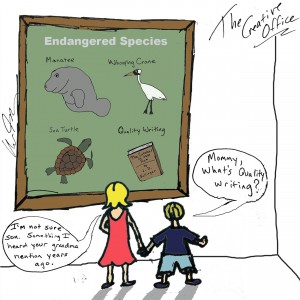Is Quality Content an Endangered Species?
I can’t play the harmonica.
I have a half-dozen “how to play the blues harp” handbooks in my desk drawer, and they’re all useless because I have zero musical ability and lack the discipline to sit down and practice.
But that’s okay. The skills I’ve tried to hone — I like to think of writing as one — have served me well over the years.
Write good?
Yesterday, Kathleen Gossman shared a Max Nisen column on the current state of humanities training, writing in particular. Due to lack of  funding and general political undermining, educators in the humanities are often under-trained and over-extended. This directly impacts today’s students, many of whom “graduate [from college] without being able to write clearly.”
funding and general political undermining, educators in the humanities are often under-trained and over-extended. This directly impacts today’s students, many of whom “graduate [from college] without being able to write clearly.”
Nisen goes on to offer this token of truth:
De-emphasizing, de-funding, and demonizing the humanities means that students don’t get trained well in the things that are the hardest to teach once at a job: thinking and writing clearly.
The scary part? These shortcomings are not unique to those entering (or soon to enter) the workforce. There are key decision-makers at companies large and small who are either in denial about the value of quality content or poorly equipped to develop successful content plans.
Heading in different directions
I’ve been in the web content marketing business for more than 10 years now and witnessed the trend-driven ways the industry tries to define “quality content,” from the .com days’ love affair with licensing to the rise of UGC.
That said, where the industry is focused today is a most gratifying place: original content that is relevant and engaging. But if the Web (more than 200 million users per month in the US) demands quality content, what does it mean when a hefty number of our skilled workforce is ill equipped to deliver it?
Who produces your quality content?
The production of quality content isn’t just a “quick roll out” kind of thing you can manage on the cheap with a fleet of interns and streetcar vendors. It requires business-savvy intangibles like:
1- Insight – about audience, brand and competitors
2- Planning – how much, when and where will you publish?
3- Execution – who will do it? when? how?
4- Measurement – will it work? how will you know?
5- Leadership – who guides the ship and makes the tough calls?
6- Adaptability – can you change gears quickly and intelligently?
How important is your brand’s content?
Today more than ever, your Web content is a valuable brand asset – it’s not a commodity, and it’s much more than necessary expense. It sets you apart, allows you to reach old and new audiences and, if you do it right, positively impacts your bottom line.
If content is important to your brand, does the makeup of your team reflect it? Let me know… I’ll be practicing my harmonica in the meantime!
Joseph Hall – VP, Content Marketing



